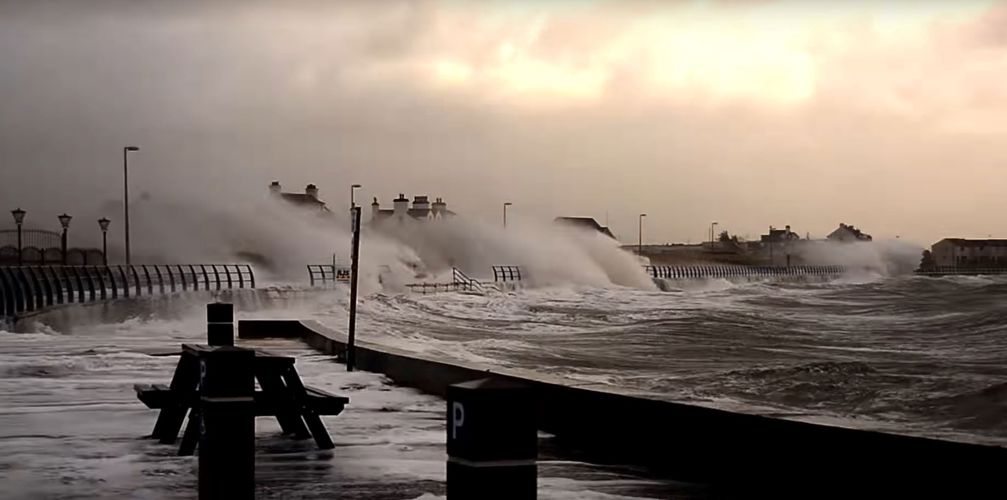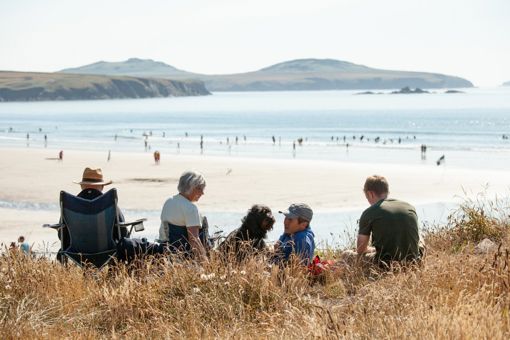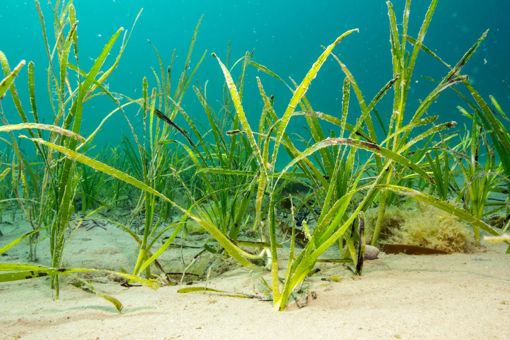Nature-based solutions and adaptation at the coast

Image by John Briggs
Why this theme?
Wales’ vast coastline is vitally important to the people of Wales. It stretches for 2740km with 60% of the population choosing to live at, or near to, the coast. It is an important space for biodiversity, with 75% of the coastline designated for environmental importance. It also supports recreation and tourism which is a huge boost for well-being and local economies. The coast is a precious resource that requires careful, sustainable management to continue providing these benefits now and into the future.
 © Crown copyright (2019) Wales
© Crown copyright (2019) Wales
Our coastlines should naturally change over time. However, human intervention has manipulated what happens there. Many coastal communities around Wales rely on coastal defences to protect them against tidal flooding and erosion. An estimated £3 billion of damages were avoided during the winter of 2013/14 thanks to our coastal defences.
Climate change will result in rising sea levels and increased storm events. Wales’ coast is not currently environmentally, socially or economically resilient to these pressures. In some places it will no longer be sustainable to maintain the current defences in the long-term. This means that we must plan to adapt as some communities, roads, railways, utilities, farms and other infrastructure and businesses on the coast will find themselves at risk.
 Image by John Briggs
Image by John Briggs
Shoreline Management Plans are high-level plans that set out where we should continue to defend the coastline and where it would be more sustainable to adapt over time. They break the coastline down into smaller sections known as ‘policy units’. They explain how the policy units should be managed over the short-term (2005-2025), the medium-term (2025-2055) and the long-term (2055-2105) with one of the following management policies for each period of time:
- Hold the line by maintaining or changing the existing standard of protection
- Advance the line by extending new defences in to the sea (none applied in Wales)
- Managed realignment which allows the shoreline to move backwards and forwards, with management to control or limit the movement
- No active intervention where there is no investment in coastal defences and natural processes are allowed
The figure below demonstrates the preferred management policies across the three time periods. It clearly illustrates the planned shift from continuing to defend to a more adaptive approach in some locations.

Where there are planned changes to ‘managed realignment’ or ‘no active intervention’, sections of coast will lose their current protection. Difficult decisions will need to be made and significant evidence gathering, engagement and resource investment is required to begin preparing for coastal adaptation.
Where defences will be maintained, such as in densely populated locations, we have choices about how this is achieved. We can choose the type of defence we have historically opted for, such as seawalls, groynes and breakwaters (sometimes called ‘hard’ or ‘grey’ infrastructure). Or, we can look at using ‘green infrastructure’, also known as ‘nature-based solutions’.
Nature-based solutions offer coastal defence but, unlike traditional solutions, can provide many other benefits. For instance, we can replenish beaches or protect saltmarshes as a way of defending our coast. This approach can simultaneously create habitats for wildlife, protect carbon stores, be places for us to enjoy and can attract tourism to boost local economies. Saltmarshes, in particular, are important habitats and incredibly efficient carbon stores, making them potentially very useful in our efforts to combat climate change.
There are also ‘hybrid approaches’ which can bridge the gap between green and grey infrastructure. Examples of this include installing structures on the sea-facing side of an existing defence to trap sediment and encourage saltmarsh growth. This saltmarsh then protects the defence structure as well as providing other benefits for the ecosystem.
 Image Ally Evans, Ecostructure Project
Image Ally Evans, Ecostructure Project
There are many examples of how to use nature-based and hybrid solutions at the coast but, unfortunately, it is not yet common practice in Wales. There is a lot of research going on to try and work out why that is. The Ecostructure project is researching potential solutions and is also working directly with developers and local communities to consider options and raise awareness.
Our coastline, along with the species, habitats and communities that it supports, is facing significant change. We are at a crucial point in time where we have a real opportunity to examine what is needed to support our coastal areas to adapt and become more resilient. What we do now can bring benefits to both nature and the people living around our coast. This theme explores how we can achieve multiple benefits as we prepare for, and adapt to, these changes.
What would success look like?
Together with our partners, we recognise that there are a number of barriers to overcome to achieve sustainable coastlines:
How can we improve public understanding around these issues?
We know that there are nearly 100 locations around Wales which will need detailed adaptation planning. However, many people and communities that may be at risk aren’t aware of the need to adapt or how it might affect them.
In addition, more could be done to explain what nature-based solutions could actually look like, where they can be used effectively and the benefits they might offer.
Can we help to simplify complex legal requirements?
There are cases in Wales where managed realignment has begun to take place, either planned or in response to natural events – like that of Cwm Ivy in the north Gower. These cases have shown us that there is conflicting legislation around public rights of way, highways, heritage and potentially more which could prevent us from managing realignment of the coast where planned.
Can funding and incentivisation help?
The huge changes that are required in order to adapt at the coast can be extremely costly to government, local authorities, Network Rail, highway authorities, landowners and the general public. We know that we need to explore funding options to support coastal adaptation.
There also needs to be more support to help get nature-based solutions funded. We need to be able to value their wider benefits so that they can be incorporated into decision-making about the defences we choose.
 Image by Amy Martin
Image by Amy Martin
What do we need to better understand the risks and benefits of nature-based solutions?
We need to gather more evidence on what types of nature-based solutions are possible around Wales and start using them where appropriate. By using nature-based solutions, we will develop confidence in their application and ensure they are genuinely considered alongside traditional solutions.
 Images provided by Conwy Council
Images provided by Conwy Council
How we are improving access to information and guidance?
We’ve created a new page about Nature-based solutions for coastal management. This includes links to nature-based solutions resources, coastal management case studies, guidance, and evidence platforms.
The page gives information about the risks, benefits and value for money when using nature-based solutions in coastal flood defence schemes. This will help stakeholders, public sector bodies, and organisations explore the opportunities to use nature-based solutions.
How should we plan and prioritise our work to deliver coastal adaptation?
We need to develop a way of collectively agreeing and prioritising which locations require detailed planning first. We can then work together to deliver those detailed plans, ensuring that we reflect upon progress, successes and challenges to help us move forwards.
 Image by John Briggs
Image by John Briggs
Having identified and started to explore these challenges, we collectively agreed a vision for this theme:
‘Wales has a sustainable and resilient coastline through the delivery of coastal adaptation in line with Shoreline Management Plans and nature-based solutions as a part of coastal management wherever possible”.
We all acknowledged that there are many locations around Wales which we must continue to defend in the future. This gives us many opportunities to consider using nature-based solutions for our coastal defences. As a group we agreed that success for nature-based solutions would be:
- Where we have invested in a coastal defence, nature-based solutions have been considered and implemented where appropriate. We would monitor this increased uptake to check the solutions have been successful
- Barriers preventing the uptake of nature-based solutions have been reduced
With 50% of locations around Wales set to move away from traditional defences and look to ‘managed realignment’ of the coast or ‘no active intervention’ by 2055, we recognise that there is substantial work needed to allow this change to happen. As a group we agreed that success for coastal adaptation would be:
- Shoreline Management Plan short-term policies (2005-2025) have been implemented OR there is a clear understanding of the barriers to implementation and there is a forward plan in place
- We have started planning for Shoreline Management Plan medium-term policies (2025-2055) to adapt our coastline (stakeholders have already been identified and are aware of the need for change)
Who have we worked with to date?
We have worked with the Wales Coastal Groups Forum and the four individual Coastal Groups in Wales to explore and develop this theme. Alongside Natural Resources Wales, group members include maritime local authorities, the Welsh Local Government Association, Welsh Government, National Trust, Network Rail and archaeological trusts.
These groups bring together a range of stakeholders who have been involved in the development and implementation of Shoreline Management Plans. They have been critical for agreeing a shared vision for this theme as well as identifying and prioritising actions to get us there.
We will continue to work with these groups and are grateful for their contributions so far. In the future, we would like to broaden our engagement and speak with the general public especially with communities that are likely to be affected. We’d also like to speak with other asset and landowners at the coast such as infrastructure providers (utility companies), caravan park owners, leisure providers, farmers, port authorities and more.
The land-based Area Statements all have stretches of coastline and we will continue working together to address the matters under this theme. We will work particularly closely with areas that include those communities that are most at risk.
What are the next steps?
We collectively identified the actions below to help us achieve our shared visions of success. These actions will involve members of the Wales Coastal Groups Forum and individual coastal groups, but may also be led by others. A key assumption we have made when identifying these actions is that resources would be available, but we recognise that this may remain challenging.
To improve public understanding of the issue:
- Scope and deliver communications at the national, local authority and community level to help improve understanding of coastal process risks and the need to adapt
- Scope and deliver wider communications about coastal adaptation beyond coastal practitioners (these can be extensions of existing channels, e.g. Public Service Boards, or new routes entirely)
- Make data regarding coastal adaptation and nature-based solutions as available and accessible as possible (one example could be to use local interactive information boards in relevant areas)
To improve access to guidance and information:
- Support the Welsh Government to develop a coastal adaptation toolkit which will inform the approach for detailed adaptation planning and community engagement
- Develop guidance to inform and support nature-based solutions, including mapping areas of opportunity and training for decision-makers
To address the complex legal requirements that can be a barrier to implementation:
- Undertake a detailed scoping exercise to understand the full range of legislative issues blocking coastal adaptation and where there are contradicting aspirations
To improve understanding about the benefits and risks associated with nature-based solutions:
- Improve information on risks, lifetime of scheme and maintenance requirements associated with nature-based solutions. Review the information on risks in the Flood and Coastal Erosion Risk Management Joint Research & Development Programme and explore how to make this information more user-friendly
To support the planning and prioritisation of key work:
- Develop a shared view with Coastal Groups on locations where coastal adaptation needs to be implemented, informed by Shoreline Management Plan policies
- Create a methodology to prioritise locations which need detailed coastal adaptation planning. Identify and work with local stakeholders to agree a list of prioritised locations at a local scale
- Working with key stakeholders, develop and implement detailed, local (project-scale) coastal adaptation plans for priority Shoreline Management Plan policy units in the short term (2005-2025). These should also be underway for the highest priority locations for the medium term (2025-2055)
- Natural Resources Wales to share information on potential sites for managed realignment being considered by the National Habitat Creation Programme to improve collaboration in the delivery of the Programme
- Ensure Local Development Plans show locations where coastal adaptation is required to prevent inappropriate development
To determine how funding and incentivisation can help to support implementation of Shoreline Management Plan policies and more nature-based solutions:
- Consider how coastal defence business cases can be informed or scored with respect to delivery against well-being goals
- Amend the draft National Flood and Coastal Erosion Risk Management Strategy measure 13 to specifically report on coastal nature-based solutions
- Explore and develop the following to support both coastal adaptation and nature-based solutions:
- cross-sectoral funding (government departments and third parties)
- short-term funding options to help deliver schemes to build knowledge and experience (e.g. ring-fenced budget)
- information to support business case development on partnership funding opportunities to deliver collaborative projects
How does what we’ve proposed deliver Sustainable Management of Natural Resources (SMNR)?
We have actively engaged with the Wales Coastal Groups Forum to develop the actions under this theme. The group agreed a shared long-term vision for the coastline of Wales. Taken together, the actions we have identified here should help deliver Shoreline Management Plans and prevent unsustainable development at the coast.
 Image provided by the National Trust
Image provided by the National Trust
The actions we have identified seek to enable the adaptive management of the Welsh coastline in response to climate change and coastal processes. We want to encourage nature-based solutions in coastal defences to harness multiple benefits such as well-being, carbon capture and building resilience of our coastal ecosystems.
We have identified the need to make existing evidence more accessible to those that need it. We also need to improve the evidence on costs and benefits to support better take up of nature-based solutions and adaptation at the coast.
A key focus in our actions is to raise public awareness and participation, particularly in those communities that are likely to be most affected by climate change and coastal adaptation in the future.
How can people get involved?
This theme is only the beginning of the journey as we work with people in Wales to improve the management of our coasts and seas. If you would like to be part of this process, please get in touch. You can also email us direct at: marine.as@cyfoethnaturiolcymru.gov.uk




